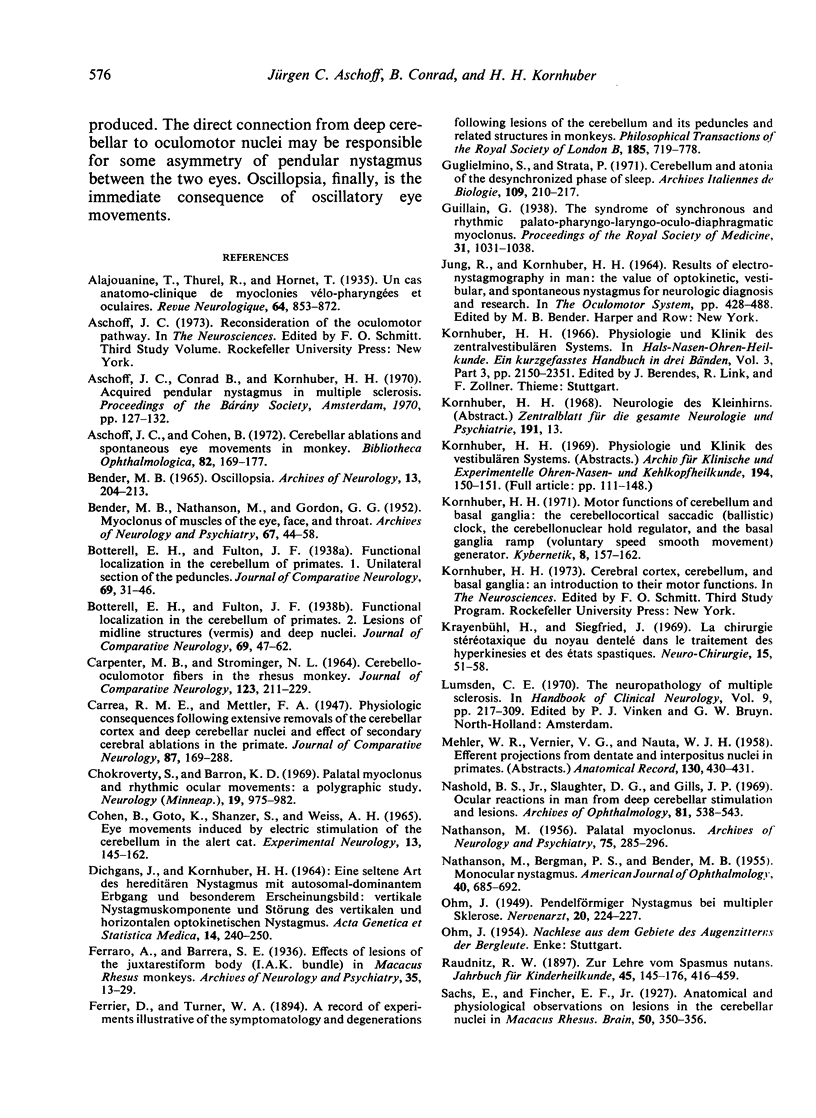Abstract
In an unselected series of 644 cases of multiple sclerosis, 25 cases with acquired pendular nystagmus were found. Ten additional cases of pendular nystagmus in multiple sclerosis were investigated, and four cases from the literature are analysed. Acquired pendular nystagmus is purely sinusoidal in form, ceases with eye closure, is accompanied by oscillopsia, often monocular and vertical in direction, and never accompanied by optokinetic inversion. This is different from congenital nystagmus. Acquired pendular nystagmus in multiple sclerosis shows a high correlation with holding tremor of head and arm and with trunk ataxia, and must therefore be viewed as a result of lesions of cerebellar nuclei or their fibre connections with the brain-stem. Supporting evidence is discussed. The results fit into a theory of cerebellar function according to which the cerebellar nuclei are involved in the maintenance of positions.
Full text
PDF







Selected References
These references are in PubMed. This may not be the complete list of references from this article.
- Aschoff J. C., Cohen B. Cerebellar ablations and spontaneous eye movements in monkey. Bibl Ophthalmol. 1972;82:169–177. [PubMed] [Google Scholar]
- BENDER M. B., NATHANSON M., GORDON G. G. Myoclonus of muscles of the eye, face, and throat. AMA Arch Neurol Psychiatry. 1952 Jan;67(1):44–58. doi: 10.1001/archneurpsyc.1952.02320130050004. [DOI] [PubMed] [Google Scholar]
- BENDER M. B. OSCILLOPSIA. Arch Neurol. 1965 Aug;13:204–213. doi: 10.1001/archneur.1965.00470020094013. [DOI] [PubMed] [Google Scholar]
- CARPENTER M. B., STROMINGER N. L. CEREBELLO-OCULOMOTOR FIBERS IN THE RHESUS MONKEY. J Comp Neurol. 1964 Oct;123:211–229. doi: 10.1002/cne.901230206. [DOI] [PubMed] [Google Scholar]
- Chokroverty S., Barron K. D. Palatal myoclonus and rhythmic ocular movements: a polygraphic study. Neurology. 1969 Oct;19(10):975–982. doi: 10.1212/wnl.19.10.975. [DOI] [PubMed] [Google Scholar]
- Cohen B., Goto K., Shanzer S., Weiss A. H. Eye movements induced by electric stimulation of the cerebellum in the alert cat. Exp Neurol. 1965 Oct;13(2):145–162. doi: 10.1016/0014-4886(65)90105-6. [DOI] [PubMed] [Google Scholar]
- DICHGANS J., KORNHUBER H. H. EINE SELTENE ART DES HEREDITAEREN NYSTAGMUS MIT AUTOSOMAL-DOMINANTEM ERBGANG UND BESONDEREM ERSCHEINUNGSBILD: VERTIKALE NYSTAGMUSKOMPONENTE UND STOERUNG DES VERTIKALEN UND HORIZONTALEN OPTOKINETISCHEN NYSTAGMUS. Acta Genet Stat Med. 1964;14:240–250. [PubMed] [Google Scholar]
- Guglielmino S., Strata P. Cerebellum and atonia of the desynchronized phase of sleep. Arch Ital Biol. 1971 Nov;109(3):210–217. [PubMed] [Google Scholar]
- Guillain G. The Syndrome of Synchronous and Rhythmic Palato-Pharyngo-Laryngo-Oculo-Diaphragmatic Myoclonus: (Section of Neurology). Proc R Soc Med. 1938 Jul;31(9):1031–1038. doi: 10.1177/003591573803100902. [DOI] [PMC free article] [PubMed] [Google Scholar]
- Kornhuber H. H. Motor functions of cerebellum and basal ganglia: the cerebellocortical saccadic (ballistic) clock, the cerebellonuclear hold regulator, and the basal ganglia ramp (voluntary speed smooth movement) generator. Kybernetik. 1971 Apr;8(4):157–162. doi: 10.1007/BF00290561. [DOI] [PubMed] [Google Scholar]
- Kornhuber H. H. Physiologie und Klinik des vestibulären Systems. Arch Klin Exp Ohren Nasen Kehlkopfheilkd. 1969;194(1):111–148. [PubMed] [Google Scholar]
- Krayenbühl H., Siegfried J. La chirurgie stéréotaxique du noyau dentelé dans le traitement des hyperkinésies et des états spastiques. Neurochirurgie. 1969 Jan-Feb;15(1):51–58. [PubMed] [Google Scholar]
- NATHANSON M., BERGMAN P. S., BENDER M. B. Monocular nystagmus. Am J Ophthalmol. 1955 Nov;40(5 Pt 1):685–692. doi: 10.1016/0002-9394(55)91496-3. [DOI] [PubMed] [Google Scholar]
- NATHANSON M. Palatal myoclonus; further clinical and pathophysiological observations. AMA Arch Neurol Psychiatry. 1956 Mar;75(3):285–296. [PubMed] [Google Scholar]
- Nashold B. S., Jr, Slaughter D. G., Gills J. P. Ocular reactions in man from deep cerebellar stimulation and lesions. Arch Ophthalmol. 1969 Apr;81(4):538–543. doi: 10.1001/archopht.1969.00990010540013. [DOI] [PubMed] [Google Scholar]
- WALBERG F., POMPEIANO O., WESTRUM L. E., HAUGLIE-HANSSEN E. Fastigioreticular fibers in the cat. An experimental study with silver methods. J Comp Neurol. 1962 Oct;119:187–199. doi: 10.1002/cne.901190205. [DOI] [PubMed] [Google Scholar]


